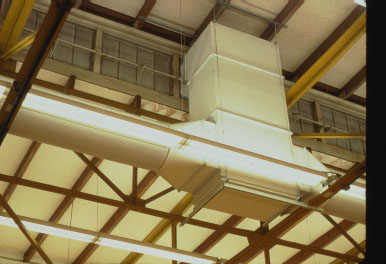
It was the combination of an ingenious HVAC design by Al Heitz, a former president of mechanical engineering consultant firm, Heitz Engineering, Roseville, California, and a strategic installation schedule by mechanical contractor, Bangar Contractors Inc., Sacramento, Calif., that eliminated downtime and saved the 85-year-old college upwards of 40 percent over the material, fabrication and installation costs of metal duct.
Installing several tons of metal duct would have necessitated a two-week closing of the gym. Consequently, college officials jumped at Heitz's suggestion of using a fabric duct air distribution system manufactured by FabricAir Inc., Louisville, Ky, because it took only a couple of days to install during the busy gym's regularly scheduled downtimes. Because SCC, which is part of the Los Rios Community College District, is the most established higher learning institution in Sacramento, its 20,000 students depend heavily on the gym's availability.
With no previous experience in the FabricAir system, Bangar Contractors spent only two days anchoring the track system to the gym's 25-foot-high ceiling and one day of actual duct installation, all which was performed without sports activity interruption. "We saved a lot of labor just in the fact that the duct arrived via United Parcel Service," said Alex Javier, Bangar's vice president, "then it went up a lot faster than what we had estimated, which resulted in an additional savings."
"For exposed duct applications, we really think fabric duct could be the wave of the future once architects and consulting engineers realize how much time, money and labor it saves over metal duct." recalled Dan Brown, president of Air Tech Sales, a Roseville, Calif-based manufacturer's representative firm that helped Heitz sell the fabric duct concept to the college.
Not only was rooftop load bearing a non-issue because fabric duct weighs 90 percent less than metal duct, but the fabric duct choice saved SCC an estimated 40 percent in materials, fabrication and labor, according to Brown.

Heitz also specified two Carrier, Syracuse, N.Y., 15,000 cfm air handlers, which are strategically placed on an adjacent sub-roof directly outside the gym's ceiling level windows. Each of the two air supplies is ducted through a window to an interior metal plenum that supplies large 26-inch-round trunk lines of fabric duct.
Return air is handled simply with one large grill located high on each end of the facility. The grills are sized proportionally to 50 percent of the supply air. "I always wanted 50 percent make-up air and didn't want varying degrees of static pressure inside the building envelope by making a true economizer cycle," Heitz explained. "So we set the system up with 50 percent make-up air and 50 percent outside air."
The 50/50 mix also surpasses compliance with the California code of 7.5 cfm of outside air per person for buildings with non-fixed seating (the gym's retractable bleachers are considered non-fixed).
Heitz saved the college additional money on the project by replacing an aging 60-ton chiller in the adjacent cafeteria with a 75-ton Carrier screw chiller that now handles both facilities and is controlled by a Honeywell, Minneapolis, Minn., automated building control system.
The 11-year-old Bangar, which also performs many design/build services in addition to its regular mechanical and sheet metal contracting, hopes to pitch the idea of fabric duct to its clients on exposed ductwork projects, according to Javier. "it appears to be a very good alternative, plus it's light and fairly easy to install," he said.
Heitz, who recently retired from 35 years of engineering and consulting, wishes fabric duct was available for many of his past projects such as multipurpose rooms in schools, "I think fabric duct has many purposes from aesthetics, function, and cost savings, but in SCC's instance, it eliminated the problem of closing the gym for two weeks," Heitz said.
For more information, contact FabricAir Inc. at 502-493-2210.
Publication date: 02/19/2001




